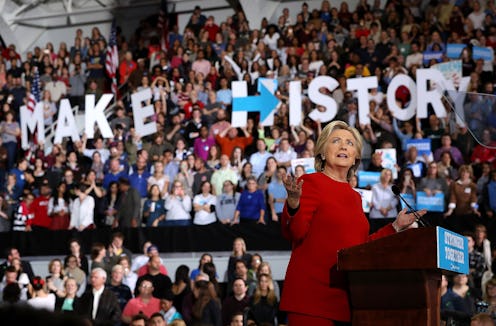News
This Tweet Captures Trump's Voter Diversity Proble
It's been a long, long election cycle for the American electorate, as we've been bombarded by scandals, WTF moments, and October Surprises that would have brought down candidates in previous years. Many voters are understandably tired, depressed, and profoundly disappointed that this year's candidates are the best America could do. As has been noted time and again, Hillary Clinton and Donald Trump are the two most unpopular candidates in U.S. presidential polling history.
But people are turning out to vote, and many have noted that while Clinton's coalition relies on Latinos, African Americans, and other minorities, Trump's base is pretty white and male. So there's a sense of poetic justice that a young German man was the one to boil down the election issues into perhaps the clearest terms yet. Twitter user Marcel Rorhlack distilled the election into a set of simple but powerful emojis.
If you're looking for a simple way to understand what kind of president you're voting for, Rorhlack's tweet sums up what a Trump administration would look like, compared to a Clinton administration. Rohrlack is a spokesperson for an environmental group known as Green Youth Munich, and is that party's official candidate for a Munich-based seat in Germany's Bundestag, the national parliament. His website outlines a progressive platform that includes fighting for LGBT and gender equality, championing many of the same issues included in the Democratic Party Platform in the U.S.
While Rohrlack's tweet is certainly an over-simplified portrayal of the 2016 American election, according to Pew Research Center, the demographics of the Democratic and Republican parties are now more disparate than at any time in the nation's history. Over the past two decades, Pew found, the Republican party's registered constituents have "aged rapidly," and though the party is less white than it was in 1992, 86 percent of registered Republicans still identify as "non-Hispanic white."
By contrast, young people, people of color, the non-religious, and college-educated voters have flocked to the Democratic party, which is still 57 percent white (down from a 75 percent white party composition 24 years ago). Pew noted that the percentage of white voters who make up the GOP electorate has also declined, but at a much slower rate than the diversification of the Democratic voting bloc.
I believe that perhaps simplest validation of Rohrlack's tweet can be found in the tone of the candidates' final pitches to voters. While Trump's final campaign ad features ominous music underneath the candidate bemoaning the "corrupt establishment" that has destroyed America, Clinton's message is one of reconciliation, focusing on a brighter, kinder tomorrow.
"It’s not just my name and my opponent’s name on the ballot — it's the kind of country we want for our children and grandchildren," Clinton says in her final ad, titled "Tomorrow." She asks in it, "Is American dark and divisive? Or hopeful and inclusive? Our core values are being tested in this election."
On Tuesday, we will finally know which way America will swing.
